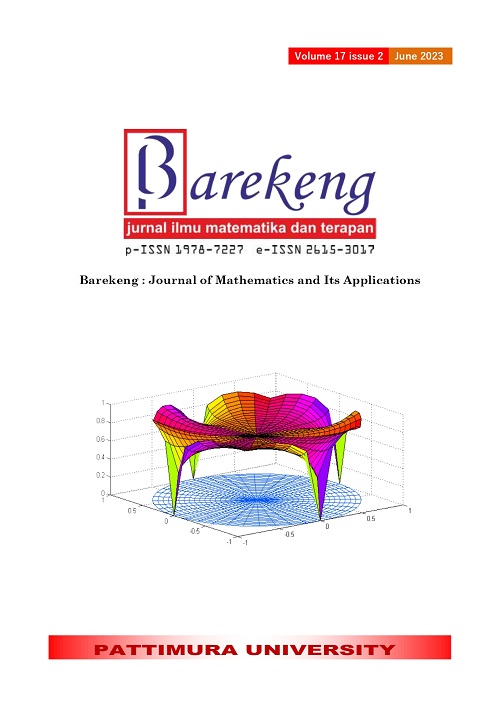HIERARCHICAL CLUSTER ANALYSIS ON PEOPLE'S WELFARE IN SOUTHEAST SULAWESI PROVINCE
Abstract
Problems with people's welfare typically result from the government's development efforts in a region not being done properly or not being done equally. Consider grouping and defining the traits of each region's degree of welfare as a potential answer to ensure that development policies and strategies are well-targeted. This study aims to classify 17 regency/cities in Southeast Sulawesi province based on several indicators of people's welfare. The method used is hierarchical cluster analysis with several approaches, including Single Linkage, Complete Linkage, Average Linkage, and Ward's. The data used in this study is secondary data obtained from the publication of the Central Agency of Statistics (CAS) of Southeast Sulawesi Province. Based on the results of the evaluation the best method used is Ward's method which produces three clusters. The first cluster consists of 9 regencies, namely Buton, North Buton, South Buton, Central Buton, Muna, West Muna, Wakatobi, Konawe Islands, and East Kolaka, the majority of which come from the archipelago. Some of the problems that occur in these areas are the relatively high poverty rate and the low average length of schooling and life expectancy. The same thing happened to the second cluster which consisted of 6 regencies, namely Konawe, South Konawe, North Konawe, Bombana, Kolaka, and North Kolaka with problems of poverty, the average length of schooling, and relatively low sources of proper drinking water when compared to other clusters. The third cluster consists of 2 urban areas, namely Kendari City and Baubau City, the problems that occur are the relatively high unemployment rate and population density. The government ought to offer more initiatives to handle issues with poverty, education, and health in regions in clusters 1 and 2. While in cluster 3, the government ought to offer more initiatives to combat jobless issues and prepare for rising population densities.
Downloads
References
W. Alwi and M. Hasrul, “Analisis Klaster untuk Pengelompokan Kabupaten/Kota Di Propinsi Sulawesi Selatan Berdasarkan Indikator Kesejahteraan Rakyat,” Jurnal Matematika dan Statistika serta Aplikasinya, vol. 6, no. 1, pp. 35–42, 2018, doi: https://doi.org/10.24252/msa.v6i1.4782.
BPS, Indikator Kesejahteraan Rakyat 2022. Jakarta: BPS RI, 2022.
BPS, Provinsi Sulawesi Tenggara Dalam Angka 2022. Kendari: BPS Provinsi Sulawesi Tenggara, 2022.
M. R. Koni, I. Djakaria, and N. I. Yahya, “Pengelompokkan Kabupaten/Kota Provinsi Jawa Timur Berdasarkan Indikator Kesejahteraan Rakyat Menggunakan Metode Elbow dan Algoritma K-Prototype,” Estimasi: Journal of Statistics and Its Application, vol. 4, no. 1, pp. 10–19, 2023, doi: https://doi.org/10.20956/ejsa.vi.24837.
D. Andiani, S. D. R. Septiani, and A. Riana, “Analisis Teknik non-Hierarki untuk Pengelompokan Kabupaten/Kota di Provinsi Jawa Barat Berdasarkan Indikator Kesejahteraan Rakyat 2020,” Jurnal Riset Matematika dan Sains Terapan, vol. 2, no. 1, pp. 21–28, 2022.
S. Yulianto and K. H. Hidayatullah, “Analisis Klaster untuk Pengelompokan Kabupaten/Kota Di Provinsi Jawa Tengah Berdasarkan Indikator Kesejahteraan Rakyat,” Statistika, vol. 2, no. 1, pp. 56–63, 2014, doi: https://doi.org/10.26714/jsunimus.2.1.2014.%25p.
A. A. R. Fernandes and S. Solimun, “Comparison of the Use of Linkage in Cluster Integration With Path Analysis Approach,” Front Appl Math Stat, vol. 8, pp. 1–10, Aug. 2022, doi: 10.3389/fams.2022.790010.
A. Tenriawaru, “Clustering Kabupaten/Kota Provinsi Sulawesi Tenggara Berdasarkan Indikator Kesejahteraan Rakyat,” semanTIK, vol. 4, no. 2, pp. 175–182, 2018, doi: 10.5281/zenodo.2528154.
R. C. Pratama and Nasrudin, “Pengelompokan Kabupaten/Kota Di Provinsi Papua Berdasarkan Indikator Kesejahteraan Rakyat 2020 (Clustering of Regencies in Papua Based on People’s Welfare Indicators 2020 ),” Seminar Nasional Official Statistics, vol. 2022, no. 1, pp. 853–862, 2022, doi: https://doi.org/10.34123/semnasoffstat.v2022i1.1236.
I. Wahyuni and S. P. Wulandari, “Pemetaan Kabupaten/Kota di Jawa Timur Berdasarkan Indikator Kesejahteraan Rakyat Menggunakan Analisis Cluster Hierarki,” Jurnal Sains dan Seni ITS, vol. 11, no. 1, pp. D70–D75, 2022, doi: http://dx.doi.org/10.12962/j23373520.v11i1.63092.
B. Žmuk, “Quality of Life Indicators in Selected European Countries: Hierarchical Cluster Analysis Approach,” Croatian Review of Economic, Business and Social Statistics, vol. 1, no. 1–2, pp. 42–54, Dec. 2015, doi: 10.1515/crebss-2016-0004.
G. Ríos-Vásquez and H. de la Fuente-Mella, “Mathematical Analysis and Modeling of the Factors That Determine the Quality of Life in the City Councils of Chile,” Mathematics, vol. 11, no. 5, pp. 1–31, Mar. 2023, doi: 10.3390/math11051218.
S. Solimun and A. A. R. Fernades, “Cluster Analysis on Various Cluster Validity Indexes with Average Linkage Method and Euclidean Distance (Study on Compliant Paying Behavior of Bank X Customers in Indonesia 2021),” Mathematics and Statistics, vol. 10, no. 4, pp. 747–753, Jul. 2022, doi: 10.13189/ms.2022.100405.
I. Digel, D. Mussabalina, M. Urdabayev, N. Nurmukhametov, and A. Akparova, “Evaluating Development Prospects of Smart Cities: Cluster Analysis of Kazakhstan’s Regions,” Problems and Perspectives in Management, vol. 20, no. 4, pp. 76–87, 2022, doi: 10.21511/ppm.20(4).2022.07.
N. S. Belinda, I. R. Hg, and H. Yozza, “Penerapan Analisis Cluster Ensemble dengan Metode Rock untuk Mengelompokkan Provinsi Di Indonesia Berdasarkan Indikator Kesejahteraan Rakyat,” Jurnal Matematika UNAND, vol. VIII, no. 2, pp. 108–119, 2019, doi: https://doi.org/10.25077/jmu.8.2.108-119.2019.
R. Silvi, “Analisis Cluster dengan Data Outlier Menggunakan Centroid Linkage dan K-Means Clustering untuk Pengelompokkan Indikator HIV/AIDS di Indonesia,” Jurnal Matematika “MANTIK,” vol. 4, no. 1, pp. 22–31, May 2018, doi: 10.15642/mantik.2018.4.1.22-31.
Copyright (c) 2023 Marsuddin Musa, Sefri Imanuel Fallo

This work is licensed under a Creative Commons Attribution-ShareAlike 4.0 International License.
Authors who publish with this Journal agree to the following terms:
- Author retain copyright and grant the journal right of first publication with the work simultaneously licensed under a creative commons attribution license that allow others to share the work within an acknowledgement of the work’s authorship and initial publication of this journal.
- Authors are able to enter into separate, additional contractual arrangement for the non-exclusive distribution of the journal’s published version of the work (e.g. acknowledgement of its initial publication in this journal).
- Authors are permitted and encouraged to post their work online (e.g. in institutional repositories or on their websites) prior to and during the submission process, as it can lead to productive exchanges, as well as earlier and greater citation of published works.






1.gif)



